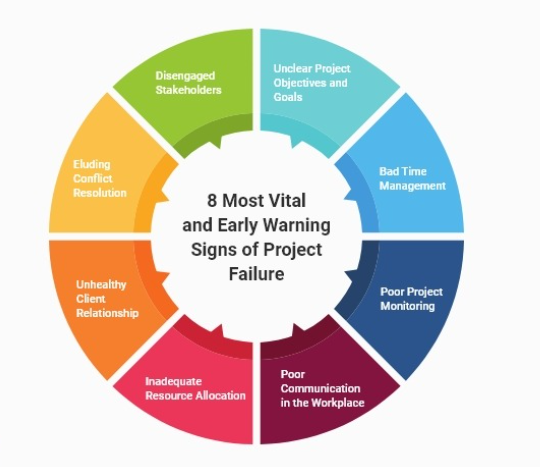Introduction
In the intricate world of app development, steering a project to success is akin to navigating a ship through stormy seas. However, when a project starts veering off course, it’s crucial to have a strategy in place to rescue it from potential failure. This guide offers a comprehensive approach to identifying, addressing, and overcoming the hurdles that threaten your app’s success, ensuring a smooth journey from conception to launch.
Recognising the Signs of a Failing Project
Identifying a project in jeopardy is the first step towards salvage. Signs of a project in distress can be subtle or glaringly obvious.
Key indicators include:
Missed Deadlines
A consistent pattern of missed deadlines suggests underlying issues in project management, resource allocation, or scope definition. It can also indicate unrealistic timelines or unforeseen complexities in the project.
Budget Overruns
Escalating costs without corresponding progress is a classic sign of a project needing intervention. This often stems from poor planning, underestimation of resources, or unexpected challenges that weren’t accounted for.
Poor Communication
A lack of clarity and open channels between team members, stakeholders, and clients can lead to misaligned objectives and expectations. This can manifest as frequent misunderstandings, a lack of engagement, and conflicts within the team.
Quality Issues
Frequent bugs or user complaints are clear indicators that the project’s quality is compromised. This could be due to insufficient testing, rushed development, or a lack of attention to detail.
Team Morale
Low morale and high turnover among team members can be symptomatic of deeper issues within the project environment. It can indicate burnout, lack of motivation, or dissatisfaction with the project’s direction or management.
Scope Creep
Uncontrolled changes or continuous growth in a project’s scope can derail the original plan and goals. This often happens when the project requirements are not clearly defined or controlled.
Inadequate Risk Management
Failure to identify and manage potential risks can lead to significant challenges down the line. This includes not having contingency plans for common project risks.
Technology or Tooling Mismatches
Choosing the wrong technology or tools for the project can lead to significant difficulties in development and implementation. This can result from a lack of research, understanding of requirements, or resistance to change from legacy systems.
Inconsistent User Feedback
If user feedback is consistently negative or highlights fundamental flaws in the app, it indicates a disconnect between the project’s output and the user’s needs or expectations.
Regulatory or Compliance Issues
Encountering legal, regulatory, or compliance issues can significantly impede progress, especially if they were not anticipated and planned for in the project’s initial stages.
Recognising these signs early on is crucial to taking timely action to steer the project back on track. Addressing these issues promptly can save a project from failure and lead to a successful outcome.
The Broader Impacts
The repercussions of a failing app project extend beyond missed deadlines and budget concerns. It can have lasting effects on your brand’s reputation, customer loyalty, and employee satisfaction. In the competitive landscape of app development, sustaining a positive brand image is crucial. A failed project can lead to a loss of trust among your user base and stakeholders, making future endeavours more challenging.
A Comprehensive Approach to App Rescue
Conduct a Thorough Project Audit
A meticulous project audit is the cornerstone of any rescue operation. It involves delving into every aspect of the project, from code quality and architecture to workflow efficiency and team dynamics. This audit should not only identify what’s going wrong but also highlight what’s working well. It’s about understanding the project’s current state in its entirety and providing a solid foundation for formulating a rescue plan.
Realign Goals and Expectations
In the face of project challenges, it’s vital to reassess and realign goals and expectations. This process involves scrutinising the original project objectives and determining their feasibility under current circumstances. It might mean scaling down features, extending deadlines, or even pivoting the project’s focus to better align with current market needs and technological trends. Setting realistic, achievable goals can reinvigorate the team and provide a clear path forward.
Enhance Communication and Transparency
Clear, consistent, and transparent communication is the lifeline of any project, especially one that is struggling. Establishing effective communication channels ensures that everyone, from the development team to stakeholders, is on the same page. Regular status updates, open forums for feedback, and transparent discussions about challenges and successes create a collaborative environment that fosters trust and teamwork.
Prioritise Features and Tasks
In rescuing a failing project, prioritisation is key. It involves evaluating the importance and impact of each feature and task, focusing on those that deliver the most value to the end-users. This might require tough decisions, like cutting features that are nice to have but not essential. The aim is to streamline the project, ensuring that efforts are concentrated on core functionalities that are crucial to the app’s success.
Strengthen Your Team
The right team can make a significant difference in turning a project around. This might involve re-evaluating team roles, bringing in additional expertise, or even reorganising the team structure for better efficiency. Investing in team training and development can also pay dividends, especially in areas where the team is lacking skills or knowledge. A motivated, skilled, and cohesive team is a vital component in the success of any project rescue effort.
Implement Agile Methodologies
Adopting Agile methodologies can be transformative, especially for projects that have lost their way. Agile’s iterative approach, with its emphasis on flexibility, continuous improvement, and responsiveness to change, is ideally suited for projects needing course correction. It allows teams to adapt quickly, test new ideas, and refine their approach based on real feedback, ensuring that the project evolves in the right direction.
Engage with Stakeholders
Engaging stakeholders is not just about keeping them informed; it’s about actively involving them in the rescue process. Their insights, feedback, and support can be invaluable. Regular stakeholder meetings, clear reporting, and open lines of communication ensure that stakeholders are aligned with the project’s new direction and are supportive of the changes being implemented.
Focus on the user experience
The ultimate goal of any app is to satisfy its users. Focusing on user experience (UX) ensures that the app meets and exceeds user expectations. This involves continual user testing, gathering user feedback, and making iterative improvements based on that feedback. A user-centric approach not only enhances the app’s usability and appeal but also helps in aligning the project’s goals with user needs.
Monitor Progress and Adjust as Needed
Effective project rescue requires ongoing monitoring and the willingness to make adjustments as needed. This involves setting up key performance indicators (KPIs) and regular checkpoints to assess the project’s progress against its goals. Being open to strategy shifts, based on this ongoing evaluation, ensures that the project remains agile and adaptable to changing circumstances.
Goal Achiever’s Turnaround with Appomate
When Goal Achiever approached Appomate, they were grappling with an inherited app that was poorly built by an overseas team. Our initial assessment revealed that simply taking over the existing project wouldn’t be cost-effective. Instead, we proposed a complete rebuild, which included a full redesign of the platform to address significant gaps in the front-end design.
Our comprehensive approach involved detailed analysis and planning. We provided a transparent quote, outlining the costs and benefits of a complete overhaul versus taking over the existing build. Recognising the critical role of user experience, we committed to redesigning their platform at our own expense.
The decision to embark on a full rebuild was a significant one. It required a complete realignment of the project’s goals and a commitment to quality and user-centric design. Our team worked tirelessly over four months, and we are now just weeks away from launching the newly revamped app on both the Apple and Google platforms. This case study exemplifies our dedication to not just rescuing app projects but transforming them into products that stand out in the market.
Play My Audio Rescue with Appomate
“Play My Audio,” an ambitious app development project, initially faced significant delays and technical issues under the guidance of its original developer. The project, planned for completion within 4 months, stretched to 9 months without a successful launch, plagued by persistent and unresolved problems.
Justin Allen, the brain behind “Play My Audio,” encountered multiple setbacks with previous developers. Disappointed by their performance, he required a reliable team to take over the project, identify the root causes of the delays and technical issues, and steer the project towards a successful launch.
Appomate, a seasoned app development company, stepped in to rescue the situation. Their first step was to conduct a thorough review of the existing app infrastructure. Contrary to the need for a complete rebuild, the Appomate team pinpointed the fundamental issues plaguing the project. By assigning two dedicated developers and focusing exclusively on resolving these core problems, Appomate managed to turn the project around.
Over the course of three months, the Appomate team worked diligently on the app. Their approach was systematic and focused, addressing each identified issue and ensuring functionality and stability were up to industry standards.
The result of Appomate’s intervention was remarkable. Within the stipulated three months, “Play My Audio” was not only functional but also ready for launch. This marked a significant turnaround from the previous nine-month delay.
Here is Justin’s review on Google.
I have been with 3 other developers before, and when I was deep into giving them a go, only to find out they were very disappointing. Appomate so far has been much better in terms of speed of development, much cheaper, listening to my email issues, applying my revisions and fixing them asap of changes to the app. I recommend when you to do with building your own app, is to just get the developer to work with you for a trial period. As stated one of the lessons from my book called; “The Treasure Map Checklist” it’s better to lose small than lose big: In terms of time, money, and energy…
Conclusion
Rescuing a failing app project is a complex endeavour that demands a strategic approach, a dedicated team, and a focus on quality and user experience.
At Appomate, we specialise in turning around app development projects and guiding them to successful completion.
If your app project is facing challenges, don’t hesitate to reach out. Our team is ready to assess, plan, and execute a rescue strategy tailored to your project’s unique needs.
Contact us today, and let’s set your startup on the path to success.

